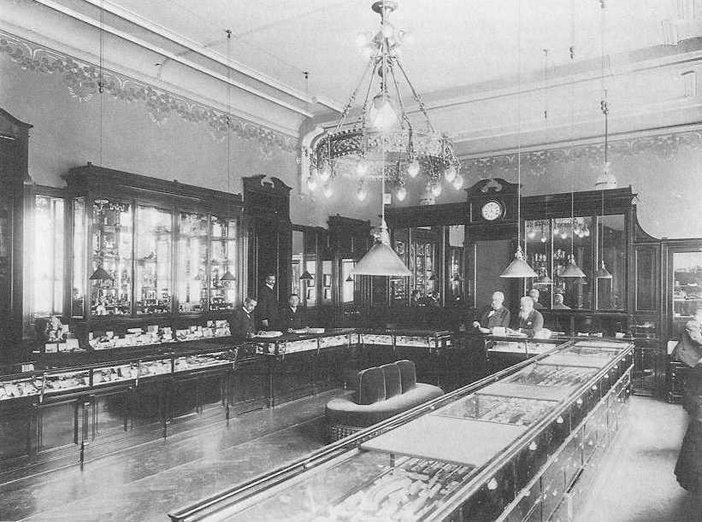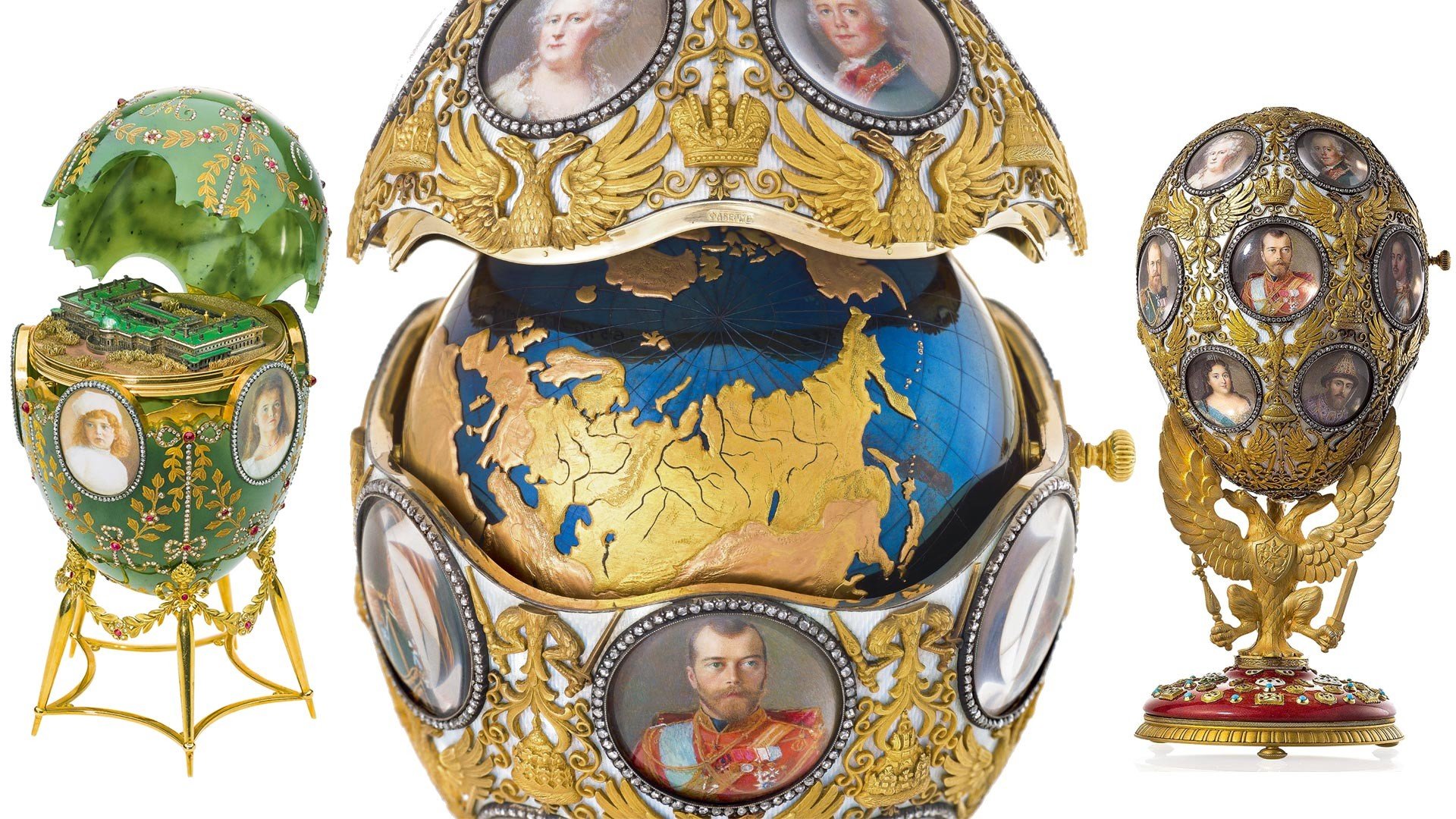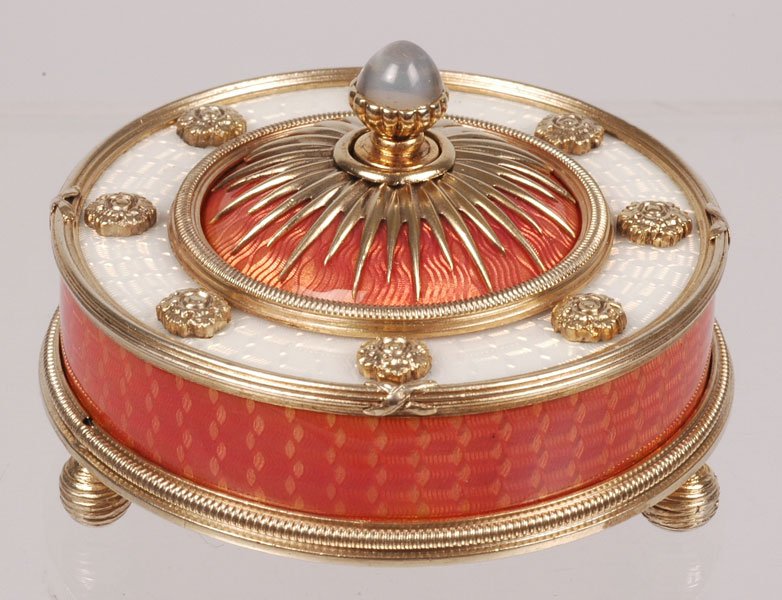How can you tell the genuine FABERGé objects from the fakes?
Well, this can be either very simple or very complicated. A lot depends upon how good the fake is.
Almost everyone has heard of the fabled "Fabergé Eggs" … fantastic gifts given at Easter time first by Emperor Alexander III to his wife, Maria Feodorovna, and then by Emperor Nicholas II to both his wife, Alexandra Feodorovna and his mother. What many people do not realize is the firm of Peter Carl Fabergé created an extraordinary variety of different items of vertu for the well-to-do, ranging from picture frames and clocks to trinket boxes, electrical bell pushes, cane handles, and beyond. At its peak in the early 1900s, the Fabergé firm had over 500 people working in their various locations throughout Russia and in their London shop. The objects offered for sale were of incomparable quality. The House of Fabergé enjoyed international acclaim and was recognized as the premier jeweler and supplier of objects deluxe to the Imperial Court of Russia. All of that changed with the Bolshevik revolution of 1917, and a year later, Fabergé was forced to close his business forever.

The interior of the Fabergé shop at 24 Bolshaya Morskaya in St. Petersburg, ca. 1910. Photo courtesy of Wartski, London
During the Soviet regime, citizens were forbidden to own jewelry and expensive bibelots. Many of the original Fabergé pieces were confiscated to be melted down for their metal value. Others were sold to western interests in order to finance the fledgling Soviet government. The pieces surviving today comprise only a small sample of those originally created, and they are highly sought by collectors all over the world. Naturally, the law of supply and demand has driven the price of these fanciful creations into the stratosphere.
Any combination of high price and high demand will present an opportunity for forgery, and objects in the Fabergé world are no exception. In fact, the production of fakes has been going on for quite some time. It has been reported even Armand Hammer, the famous industrialist and art dealer, was a major distributor of counterfeit Fabergé items. It is a not-so-well-kept secret he was actually given hallmarking tools by the Soviet government during the 1930s and stamped all kinds of Russian items with Fabergé's mark to be sold at his New York City and Palm Beach galleries.
Learning to tell the difference between the good and the bad is like any other skill-it takes practice. It often can be very subjective, and there have been times pieces have come on the market when even the experts cannot agree among themselves about authenticity. So where does one begin?

First of all, try to see as many real pieces as you possibly can. Here is a list of museums with permanent Fabergé collections. There are also temporary exhibits of Faberge's work displayed throughout the year at various venues. Christie's and Sotheby's hold regular auctions in both the US and Europe. Previewing these auctions gives the collector the opportunity to not only see some items on display, but to hold them and inspect them closely as well. The more items you see, the easier it will become to spot the fakes.

Let your eye be the initial judge. Fabergé's items are all one-of-a-kind, but there is usually a "familial resemblance" among different pieces. The Fabergé craftsmen were meticulous about details, including their incredible palate of over 140 different enamel colors, which were polished to perfection. The metal work is finely chased, leaving no spot unattended. The decorations are delicate and harmonious with the rest of the piece. Real Fabergé items have a tactile balance about them as well. It's a hard thing to describe, but when you hold them in your hand, you can sense the quality of the item. They are classy and elegant, even in their most simple designs. Fake items, on the other hand (no pun intended) will strike you almost immediately as being clumsy, garish, cheesy and over-embellished. The forgers like to stick to 2 or 3 colors of enamel, and they will use the same designs over and over again.
The hallmarks should be the next thing to examine.
Because the Fabergé hallmarks are well known and have been extensively published, you can't rely on them solely to confirm authenticity. However, they can help you dismiss some fakes. Often the forgers only have a limited number of punches, so you will sometimes see strange combinations such as the mark of the Moscow branch in conjunction with a St. Petersburg workmaster's initials, or a state hallmark from 1908-1917 along with the initials of a workmaster who died prior to that time. It is not always that easy to judge, however. One thing to remember is that the real pieces were almost always hallmarked before the item was finished. Imagine applying a punch to the gold edge of a picture frame after the enamel was fired….it would almost certainly cause irreparable damage. So in many cases, the real hallmarks are partially obliterated in the finishing of the piece, leaving just the faint trace of the name of the firm or the initials of the workmaster. Remember that hallmarking was a legal obligation, not something that was done to confirm authenticity a century later. The producers of the fake items often make their marks too good, and that should be something to watch for as well.

Buying from a reputable dealer is probably the best way to protect yourself against purchasing a fake object. Most collectors agree that dealing with a well known seller who will unconditionally guarantee authenticity is a smart move, and although the prices may seem higher than those of your local antique shop, you're paying for the security of knowing that the item is the real thing.
Fabergé never was, and still is not, a bargain on any level. Unlike other collectibles that sold for pennies when they were first introduced and have appreciated in value due to sentimental attachments, items bought at the shops of Fabergé (or Tiffany, Cartier, etc.) always commanded a premium price. It is, therefore, nearly impossible to find genuine pieces whose owners have no idea of their worth. On the other hand, many people read about the millions of dollars realized at auction on the imperial eggs and think that anything bearing Fabergé's mark is equally valuable.
Keeping that thought in mind, consider the asking price of the seller. eBay seems to have become one of the biggest outlets for unscrupulous dealers, so here is an appropriate analogy: if you were to see a mint condition luxury automobile advertised on eBay for a "buy it now" price of $1500, would you bid on it? Of course not. You would assume that this was some sort of scam, yet people continually buy fake Fabergé pieces that would be worth tens of thousands of dollars if they were authentic under the same circumstances. The old adage applies here: if it seems too good to be true, it probably is.

Always ask about the provenance of the piece being offered for sale. All genuine Fabergé objects are over 100 years old. In many cases, they have, at one time or another, been sold at one of four establishments: Wartski (London), A La Vieille Russie (New York), Sotheby's or Christie's. Be very suspicious of stories about Fabergé objects that were reputed to have been smuggled out of Russia by a relative of the seller who was escaping the Soviet regime at the time of the revolution!
Basically, collecting Fabergé requires money. Real bargains are virtually nonexistent. You are much better off saving for a single piece that may be expensive, but original, than trying to get something cheaply. It's far worse to purchase a piece that is a fake than to possibly overpay for something that is right.